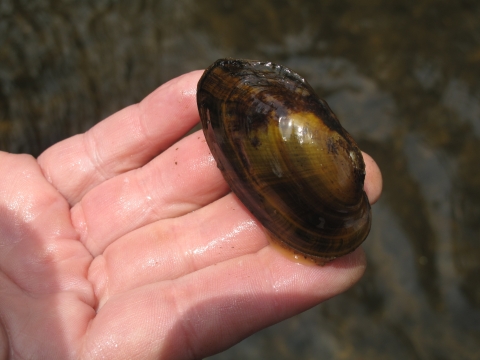In 1834, a freshwater mussel collected near the convergence of the Swannanoa and French Broad Rivers was recognized as a new species – the Appalachian elktoe. Eighty years later, Carnegie Museum curator and University of Pittsburg professor Arnold Ortman couldn’t find any elktoes in the French Broad River, attributing his failure to polluted water.
On a cold January afternoon in early 2017, Fish and Wildlife Service biologists Jason Mays and Byron Hamstead were wading the French Broad River, near Rosman N.C., speaking with a landowner who wanted to stop the soil erosion on his property. Conversation turned to mussels, and while describing good mussel habitat, something caught Mays’s eye. He reached into the water and pulled out an Appalachian elktoe mussel - the first time the mussel had ever been found that far upstream in the French Broad River. In the summer of 2017, biologists found three elktoes in the river between Long Shoals Road and Amboy Road – marking the furthest downstream the rare mussel has been found in decades. The Appalachian elktoe, on the endangered species list since 1994, is returning to the French Broad River.
Since 2000, the Appalachian elktoe has been found in Transylvania County’s Little River, and Henderson County’s Mills River – both tributaries to the French Broad River. A few years later, biologists noticed the Little River population spreading into the mainstem of the French Broad River, but the 2017 discoveries demonstrate a marked expansion of the mussel’s range in the river. As attention turns to the 2018 field season, Service biologists expect to take a closer look at the French Broad River through Asheville using seasonal help to search for mussels and working with UNC Asheville and RiverLink to deepen understanding of the aquatic life in the river among communities that rely on the river.
Despite the relative anonymity of freshwater mussels, the southeastern United States is home to the world’s greatest diversity of freshwater mussels – 269 species out of the 297 found in the United States. They’re also one of the world’s most imperiled group of animals, with 122 on the federal threatened and endangered species list.
“The return of the elktoe in the French Broad River says a lot about the improving health of the river,” said Jason Mays, biologist with the U.S. Fish and Wildlife Service. “Mussels are sensitive to water pollution, making them good indicators of water quality. Thriving mussel populations reflect a healthy river. That the elktoe is returning to the French Broad River means the health of the river is improving.”
Over the years, federal, state, and local policy have helped improve water quality and stream health. The 1972 passage of the Clean Water Act was a seminal point in the health of American rivers. The act prohibits the discharge of pollution into a stream unless permitted, and in situations where permits are issued, the water still has to be treated before being released into the stream. It’s under this law that sewage from across the city of Asheville doesn’t get dumped into the river, but rather is carried to the wastewater treatment plant, where it’s treated and the water released into the river. Erosion control regulations help keep soil from washing away and smothering stream habitat. Stormwater runoff controls help rain that falls on roofs and parking lots soak into the ground, where it recharges groundwater, instead of overwhelming a stream with a rush of volume that erodes stream banks and bottoms.
“The best indicator of stream health is always the species of animals that live in the stream. We are excited that species like the endangered Appalachian elktoe mussel are working their way further downstream each year,” said Garrett Artz, executive director, RiverLink.
The elktoe’s resurgence coincides with a time when the French Broad River is receiving much more attention as a recreation destination.
“You look at the river any Saturday afternoon in July and all those brightly-colored inner tubes tell you what an economic boon a river can be,” said Mays. “The challenge is ensuring development along the French Broad River corridor is done in a way that protects stream health.”
In 1994, when the elktoe was placed on the endangered species list, its known remaining global distribution was limited to Macon, Mitchell, and Yancey counties, North Carolina; and Unicoi County Tennessee. Since then, it has also been found in Graham, Haywood, and Henderson, Swain, Transylvania, and now Buncombe counties. Despite the new discoveries, the elktoe faces challenges. The Little Tennessee River population, in Swain and Macon counties, was the largest population fifteen years ago and has since dropped to undetectable level; the cause of the decline is poorly understood. Yancey County’s Cane River population was nearly wiped out around the time of a wastewater treatment plant failure on the river. The Mills River population in Henderson County has never been known to thrive. The challenges with the other populations mean having the elktoe in the French Broad River is increasingly important.
“In the French Broad River, we’re witnessing the resiliency of this animal over a span of decades,” said Mays. “As the quality of the French Broad River decreased, the mussel persisted in tributary streams. Now that the river’s health is rebounding, the mussel is recolonizing the French Broad. Having a healthy population across multiple, connected streams helps ensure the long-term well-being of the population.”





